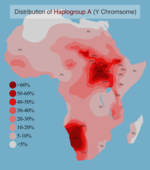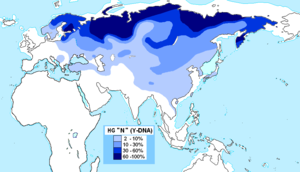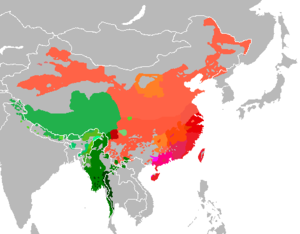父系語言假說
父系語言假說認為,人們傾向於說父親所說的語言。1997年,人們發現語言和Y染色體突變之間的聯繫比線粒體DNA突變更密切。最初的工作由Laurent Excoffier領導的人口遺傳學家小組對非洲和歐洲的樣本分析發現。[1][2]在這些和其他遺傳學佳的類似發現的基礎上,歷史語言學家無我在2010年闡述了這一機制:母親會將配偶的語言教給子女。由此,語言得以存續。[3]
以定居區的史前語言替換為重點,世界範圍的例子[4]表明只要10–20%的男性移民就可以(但不需要)引發語言替換,這說明語言替換存在精英主導性,如在新石器時代、青銅時代和鐵器時代地區內的第一批農民或金屬加工技術持有者。
早期常染色體研究
[編輯]在20世紀80年代和90年代分別發現mtDNA突變和Y染色體突變之前,[5][6]在人口遺傳學中不可能區分男性和女性分別帶來的影響。研究者們不得不依靠常染色體變異,從1919年路德維克·希爾斯菲爾德利用血型開人口遺傳學研究之先河以來,就一直如此。[7]後來又發掘了其他的基因多態性,如血漿蛋白、淋巴細胞抗原和免疫球蛋白的多態性。[8]在此基礎上,人們偶爾會懷疑語言和基因突變之間是否存在關係,[9][10]但直到20世紀90年代,人類mtDNA和Y染色體突變都可用於研究時,才能解決特定性別的影響的問題。
假說的起源
[編輯]Y染色體遵循父系遺傳,意味着它只在男性間傳遞,從父親傳給兒子。另一方面,線粒體DNA遵循母系遺傳,也就是它只從母親傳給自己的孩子。1997年,Laurent Excoffier和他的學生Estella Poloni及其團隊報告說,他們發現Y染色體序列P49a,f/Taql變異與語言間有很強的相關性,而mtDNA突變則找不到這種對應。Poloni等人據此提出了父系語言假說:
- 「因此,拿我們基因組中女性特有的多樣性與地理學和語言學相比較時,不如拿男性特有的更適合。[...]如果事實證明是這樣的話,那麼我們說『母語』的普遍信念就該被糾正,因為『父語』更加貼合事實。」[1]
Estella Poloni還在2000年4月巴黎舉行的國際會議上正式提出了「父系語言假說」。[11]
在此基礎上,歷史語言學家無我在他的民族語言學出版物和他參加合著的人口遺傳學出版物中闡述了父系語言假說。[12]2002年台北舉行的印度-太平洋史前協會會議上,他提出
- 「在整個語言史上,母親教孩子學習父親的語言是一個反覆出現、無處不在、普遍存在的模式,[…]語言隨時間變化的一些機制可能是這種傳播途徑的內在動力。這種關聯性在全世界都能觀察到。」[13]
語言Y染色體標記的發現
[編輯]接下來的發展是發現了一種與語言相關的特定Y染色體標記。[14][15][16]這些Y染色體突變並不會導致語言的變化,而是碰巧被男性傳播者攜帶。這些語言的特異Y染色體標記創造了Poloni等人於1997年觀察到的相關性,並進一步允許確定未記錄的(史前)語言變化的地理範圍、時間深度和男性移民水平。
父系語言的例子
[編輯]有幾個突出例子表明,語系的史前傳播與Y染色體單倍群突變的傳播密切相關。[4]
- 據墳塚假說,原始印歐人從東歐大草原中的原鄉開始的擴散,與單倍群R亞群R1a1向歐洲的擴散有關。[14]R1a1可能也反映了印度-雅利安人對印度北部的入侵。[12][17]
- 單倍群L可能反映了早期來自伊朗某地的埃蘭-達羅毗荼語系的父系傳播。[17]然而,主流學界仍不接受埃蘭-達羅毗荼語系的提議。
- 南亞語系使用者有着高頻的O2a。例如,印度北部和東北部的蒙達語族使用者顯示出很高的O2a頻率,而相鄰的地區不說南亞語。他們的mtDNA單倍群常見於當地,與語言親緣無關。[15]
- 一項針對23名漢族人[18]的研究顯示,在今日華南地區的漢化過程中,漢族的擴張以男性遷徙為主,這是一個沒有爭議的父系語言假說例子。[12]
- 有人認為,班圖語支和其他尼日爾-剛果語系語言和Y染色體單倍群有很好的相關性。[19][20]
- 亞非語系的傳播與E1b1b單倍群的擴張有關。[21]
影響
[編輯]父系語言假說對語言學的幾個過程有深遠的影響,如語言變化、語言習得和社會語言學,父系語言假說歲語言習得也有影響,因為該假說對女性在語言表現和習得的某些方面可能更好地提出了演化層面的解釋。[22][23][24][25][26][27][28][29][30]
歷史語言學家無我將Y染色體單倍群和語系的相關性解釋為,語系的傳播往往是以傾向男性的遷徙為中介的,無論這些遷徙是通過軍事還是什麼。他推測,大多數語言社區說的是「父語」而不是「母語」。[17]
父系語言假說也使得語言學家對語言變化的理解發生了變化。必須假定,母親將其配偶的語言穿夠後代的語言變化動態和單語社區的語言變化動態不同,甚至與母親將自己的語言傳給孩子的雙語社區的變化動態也不同。[31]因此,這種動態可以引入與過去的不連續性。例如,據觀察,Michif語在語法上屬於阿爾岡昆語系(如平原克里語等),但被梅蒂人婦女用梅蒂法語進行了徹底的詞彙替換,因而Michif語的親緣關係幾乎難以辨識。[32][33][34]如果詞彙替換的過程超出了語言構擬的可能性,這種過程的動態可能會掩蓋一個社區真正的語言遺產。[31]
例外
[編輯]基因並不能決定一個人所講的語言,Y染色體單倍群和語言親緣關係間的聯繫是一種觀察到的相關性,而不是因果關係。雖然父方語言占主導地位,但世界上也有很多父方語言的例外。兩個非常著名的例外是巴基斯坦北部的巴爾蒂人和匈牙利馬扎爾人。 巴爾蒂人中最常見的mtDNA 單倍群和臨近的藏族社區相同,但巴爾蒂男性中最常見的Y染色體單倍群似乎是隨着伊斯蘭教的傳入從西方進入巴基斯坦的。而巴爾蒂語是最保守的藏語支語言之一。[12]巴爾蒂人的語言對應的是mtDNA,而非Y染色體單倍群。[17] 另一個例子是匈牙利語。Y染色體單倍群N1c以Tat-C缺失為特徵,常見於整個烏拉爾語系,但卻幾乎不見於匈牙利男性。因此,雖然馬扎爾人入侵如今的匈牙利存在歷史依據,並留下了明確的語言證據,但從遺傳學上看,馬扎爾人並沒有留下明顯的遺傳痕跡。相反,匈牙利人在遺傳學上非常類似於西斯拉夫語支群體。[31]
另見
[編輯]參考
[編輯]- ^ 1.0 1.1 Poloni, Estela S; Semino O, Passarino G, Santachiara-Benerecetti AS, Dupanloup I, Langaney A, Excoffier L. Human genetic affinities for Y-chromosome p49a,f/TaqI haplotypes show strong correspondence with linguistics. American Journal of Human Genetics. 1997, 61 (5): 1015–1035. PMC 1716025
 . PMID 9346874. doi:10.1086/301602.
. PMID 9346874. doi:10.1086/301602.
- ^ Barbujani, Guido. Invited Editorial: DNA Variation and Language Affinities. American Journal of Human Genetics. 1997, 61 (5): 1011–1014. PMC 1716036
 . PMID 9345113. doi:10.1086/301620.
. PMID 9345113. doi:10.1086/301620.
- ^ van Driem, George. The Shompen of Great Nicobar Island: New linguistic and genetic data, and the Austroasiatic homeland revisited (PDF). Keralaputra Shreevinasaiah Nagaraja and Kashyap Mankodi (編). Austroasiatic Linguistics: Proceedings of the Third International Conference on Austroasiatic Linguistics, 26-28 November 2007. Mysore: Central Institute of Indian Languages. 2010: 224–259.[失效連結]
- ^ 4.0 4.1 Forster, Peter; Renfrew C. Mother Tongue and Y Chromosomes. Science. 2011, 333 (6048): 1390–1391. Bibcode:2011Sci...333.1390F. PMID 21903800. S2CID 43916070. doi:10.1126/science.1205331.
- ^ Ferris, SD; Brown WM, Davidson WS, Wilson AC. Extensive polymorphism in the mitochondrial DNA of apes. Proceedings of the National Academy of Sciences of the USA. 1981, 78 (10): 6319–6323. Bibcode:1981PNAS...78.6319F. PMC 349030
 . PMID 6273863. doi:10.1073/pnas.78.10.6319
. PMID 6273863. doi:10.1073/pnas.78.10.6319  .
.
- ^ Underhill, Peter; Jin L, Lin AA, Mehdi SQ, Jenkins T, Vollrath D, Davis RW, Cavalli-Sforza LL, Oefner PJ. Detection of numerous Y chromosome biallelic polymorphisms by denaturing high-performance liquid chromatography. Genome Research. 1997, 7 (10): 996–1005. PMC 310671
 . PMID 9331370. doi:10.1101/gr.7.10.996.
. PMID 9331370. doi:10.1101/gr.7.10.996.
- ^ Hirszfeld, L; Hirszfeld H. Essai d'application des méthodes sérologiques au probléme des races. Anthropologie. 1919, 29: 505–537.
- ^ Cavalli-Sforza, Luigi Luca; Menozzi P, Piazza A. The history and Geography of Human Genes. Princeton, New Jersey: Princeton University Press. 1994.
- ^ Darlington, CD. The genetic component of language. Heredity. 1947, 1 (3): 269–286. doi:10.1038/hdy.1947.18
 .
.
- ^ Cavalli-Sforza, LL; Piazza A, Menozzi P, Mountain J. Reconstruction of human evolution: bringing together genetic, archaeological, and linguistic data. Proceedings of the National Academy of Sciences of the USA. 1988, 85 (16): 6002–6006. Bibcode:1988PNAS...85.6002C. PMC 281893
 . PMID 3166138. doi:10.1073/pnas.85.16.6002
. PMID 3166138. doi:10.1073/pnas.85.16.6002  .
.
- ^ Poloni, Estella Simone; et al. Languages and genes: Modes of transmission observed through the analysis of male-specific and female-specific genes. Jean-Louis Dessalles and Laleh Ghadakpour (編). Proceedings: Evolution of Language, 3rd International Conference 3-6 April 2000. Paris: École Nationale Supérieure des Télécommunications. 2000: 185–186.
- ^ 12.0 12.1 12.2 12.3 van Driem, George. Austroasiatic phylogeny and the Austroasiatic homeland in light of recent population genetic studies. Mon-Khmer Studies. 2007, 37: 1–14.
- ^ van Driem, George. The ethnolinguistic identity of the domesticators of Asian rice (PDF). Comptes Rendus Palevol. 2012, 11 (2): 117–132 [2022-12-16]. doi:10.1016/j.crpv.2011.07.004. (原始內容存檔 (PDF)於2020-02-20).
- ^ 14.0 14.1 Zerjal, Tatiana; Pandya A, Santos FR, Adhikari R, Tarazona E, Kayser M, Evgrafov O, Singh L, Thangaraj K, Destro-Bisol G, Thomas MG, Qamar R, Mehdi SQ, Rosser ZH, Hurles ME, Jobling MA, Tyler-Smith C. The use of Y-chromosomal DNA variation to investigate population history: Recent male spread in Asia and Europe. Surinder S Papiha, Ranjan Deka and Ranajit Chakraborty (編). Genomic Diversity. Applications in Human Population Genetic Studies. Williamsburg, Virginia 26 July - 1 Aug 1998. New York: Kluwer Academic/Plenum Publishers. 1999: 91–101.
- ^ 15.0 15.1 Chaubey, Gyaneshwer; et al. Population genetic structure in Indian Austroasiatic speakers: The role of landscape barriers and sex-specific admixture. Molecular Biology and Evolution. 2010, 28 (2): 1013–1024. PMC 3355372
 . PMID 20978040. doi:10.1093/molbev/msq288.
. PMID 20978040. doi:10.1093/molbev/msq288.
- ^ Rai, Niraj; et al. The phylogeography of Y-chromosome haplogroup H1a1a-M82 reveals the likely Indian origin of the European Romani populations. PLOS ONE. 2012, 7 (11): e48477. Bibcode:2012PLoSO...748477R. PMC 3509117
 . PMID 23209554. doi:10.1371/journal.pone.0048477
. PMID 23209554. doi:10.1371/journal.pone.0048477  .
.
- ^ 17.0 17.1 17.2 17.3 van Driem, George. Etyma, shouldered adzes and molecular variants. Andrea Ender, Adrian Leemann and Bernhard Wälchli (編). Methods in Contemporary Linguistics. Berlin: Mouton de Gruyter. 2012.
- ^ Wen, Bo; et al. Genetic evidence supports demic diffusion of Han culture. Nature. 2004, 431 (7006): 302–305. Bibcode:2004Natur.431..302W. PMID 15372031. S2CID 4301581. doi:10.1038/nature02878.
- ^ Wood, Elizabeth T; et al. Contrasting patterns of Y chromosome and mtDNA variation in Africa: evidence for sex-biased demographic processes. European Journal of Human Genetics. 2005, 13 (7): 867–876. PMID 15856073. doi:10.1038/sj.ejhg.5201408
 .
.
- ^ de Filippo, Cesare; et al. Y-Chromosomal Variation in Sub-Saharan Africa: Insights Into the History of Niger-Congo Groups. Molecular Biology and Evolution. 2011, 28 (3): 1255–1269. PMC 3561512
 . PMID 21109585. doi:10.1093/molbev/msq312.
. PMID 21109585. doi:10.1093/molbev/msq312.
- ^ Gebremeskel, Eyoab I; Ibrahim, Muntaser E. Y-chromosome E haplogroups: their distribution and implication to the origin of Afro-Asiatic languages and pastoralism. European Journal of Human Genetics. December 2014, 22 (12): 1387–1392. ISSN 1476-5438. PMC 4231410
 . PMID 24667790. doi:10.1038/ejhg.2014.41.
. PMID 24667790. doi:10.1038/ejhg.2014.41.
- ^ Shaywitz, B. A; et al. Sex differences in the functional organization of the brain for language. Nature. 1995, 373 (6515): 607–609. Bibcode:1995Natur.373..607S. PMID 7854416. S2CID 4315684. doi:10.1038/373607a0.
- ^ Pugh, K. R; et al. Cerebral organization of component processes in reading. Brain. 1996, 119 (4): 1221–1238. PMID 8813285. doi:10.1093/brain/119.4.1221
 .
.
- ^ Pugh, K. R; et al. Predicting reading performance from neuroimaging profiles: The cerebral basis of phonological effects in printed word identification. Journal of Experimental Psychology: Human Perception and Performance. 1997, 23 (2): 299–318. PMID 9103996. doi:10.1037/0096-1523.23.2.299.
- ^ Jaeger; et al. Sex differences in brain regions activated by grammatical and reading tasks. NeuroReport. 1998, 9 (12): 2803–2807. PMID 9760124. S2CID 41971376. doi:10.1097/00001756-199808240-00022.
- ^ Kansaku, K; et al. Sex differences in lateralization revealed in the posterior language areas. Cerebral Cortex. 2000, 10 (9): 866–872. PMID 10982747. doi:10.1093/cercor/10.9.866
 .
.
- ^ Rossell, S. L; et al. Sex differences in functional brain activation during a lexical visual field task. Brain and Language. 2002, 80 (1): 97–105. PMID 11817892. S2CID 34669770. doi:10.1006/brln.2000.2449.
- ^ Baxter, L. C; et al. Sex differences in semantic language processing: A functional MRI study. Brain and Language. 2003, 84 (2): 264–272. PMID 12590915. S2CID 12658733. doi:10.1016/s0093-934x(02)00549-7.
- ^ Clements, A. M; et al. Sex differences in cerebral laterality of language and visuospatial processing. Brain and Language. 2006, 98 (2): 150–158. PMID 16716389. S2CID 32525196. doi:10.1016/j.bandl.2006.04.007.
- ^ Burman, Douglas D.; et al. Sex differences in neural processing of language among children. Neuropsychologia. 2008, 46 (5): 1349–1362. PMC 2478638
 . PMID 18262207. doi:10.1016/j.neuropsychologia.2007.12.021.
. PMID 18262207. doi:10.1016/j.neuropsychologia.2007.12.021.
- ^ 31.0 31.1 31.2 van Driem, George. Reflections on the ethnolinguistic prehistory of the greater Himalayan region. Brigitte Huber, Marianne Volkart and Paul Widmer (編). Chomolangma, Demawend und Kasbek: Festschrift für Roland Bielmeier zu seinem 65. Geburtstag (2 vols.). Halle: International Institute for Tibetan and Buddhist Studies. 2008: 39–59.
- ^ Bakker, Pieter Jan. A language of our own: The genesis of Michif, the mixed Cree-French language of the Canadian Métis. Amsterdam: Universiteit van Amsterdam: doctoral dissertation. 1992.
- ^ Bakker, Pieter Jan. Michif, the Cree-French mixed language of the Metis buffalo hunters in Canada. Peter Bakker and Maarten Mous (編). Mixed Languages, 15 Case Studies in Language Intertwining (Studies in Language and Language Use, 13). Amsterdam: Instituut voor Fundamenteel Onderzoek naar Taal en Taalgebruik. 1994: 13–33.
- ^ van Driem, George. Languages of the Himalayas. Leiden: Brill. 2001.








